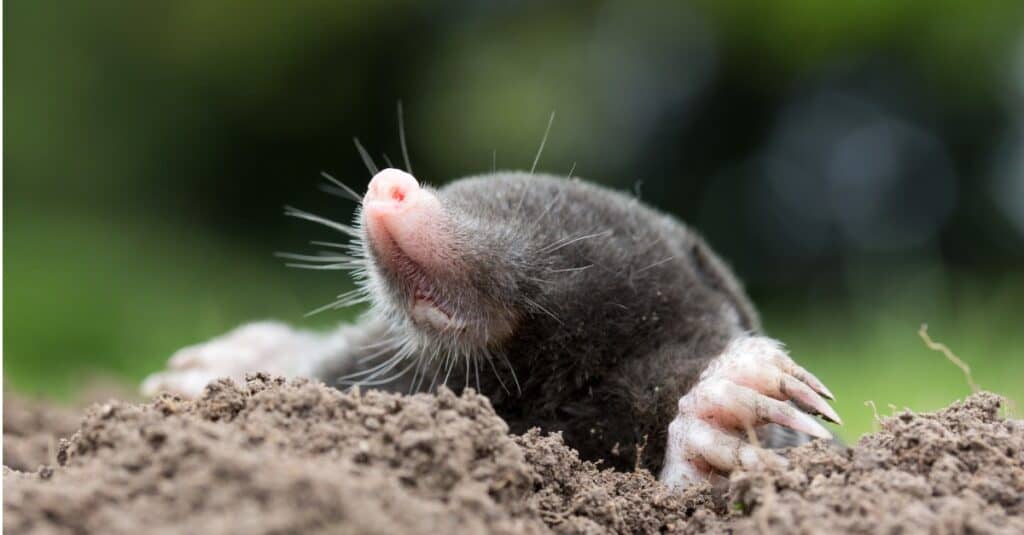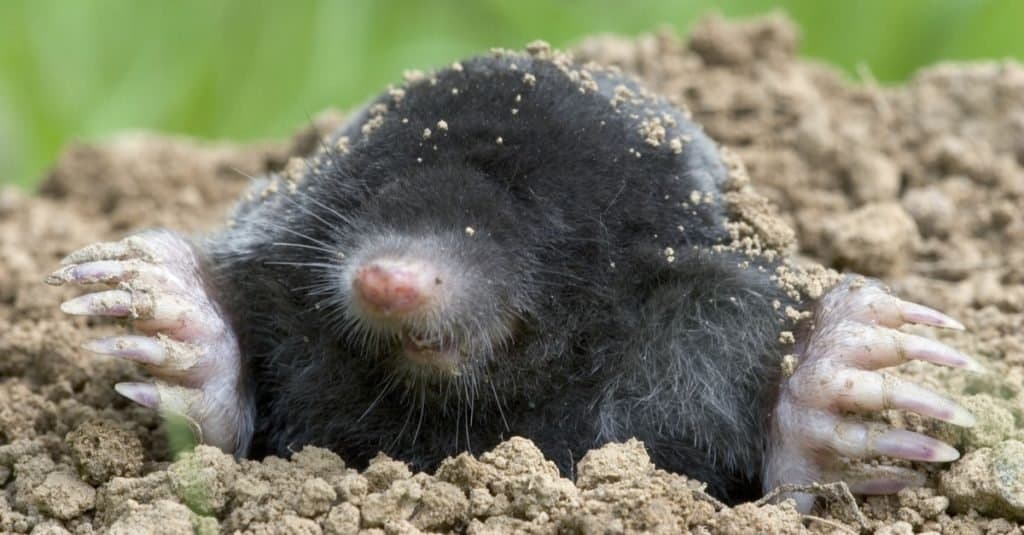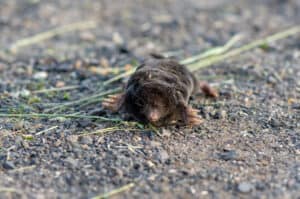Moles live underground, and people generally regard them as pests as they can ruin plant roots and gardens with their molehills. These animals are also highly active for extended periods as they forage and tunnel, causing much frustration for gardeners. But are moles nocturnal or diurnal? Here we explore the sleep behavior of these curious creatures to learn whether moles are nocturnal or diurnal.
Moles Are Not Nocturnal but Demonstrate Crepuscular Behavior

Moles are not nocturnal or diurnal but active at twilight, showing crepuscular tendencies.
©iStock.com/juefraphoto
Many people believe that moles are nocturnal, but this is not true. This misconception usually stems from people looking out their windows in the morning and seeing fresh molehills. Instead, moles are active throughout the day as they forage and move through their tunnel systems. But their activity peaks at dusk and dawn, also known as twilight, making them crepuscular animals. Most moles are active between 4 a.m. and 7 a.m., so they are most active during quiet times, such as early morning and late at night, when they can move about, largely undisturbed.
Non-Nocturnal Mole Sleep Behavior
Scientists studied the sleep behavior of moles and identified five EEG states. The five separate sleep phases of the mole comprise the following:
The Waking State
The waking state is when the moles exit their sleep state and enter their conscious state. At this time, the moles become active and go about their daily business, as this sleep phase suggests.
The Drowsy State
As the name suggests, the drowsy state is when moles leave their conscious state and wind down their activity levels in preparation to enter their sleeping state.
Spindle Sleep
The term “spindle sleep” refers to the specific patterns of brain waves that occur during the mole’s sleep pattern. Researchers use electroencephalography to identify spindle sleep, which measures electrical activity in the brain. However, researchers still do not fully understand the purpose or importance of spindle sleep. But, they believe this sleep state assists the mole in maintaining brain plasticity, learning, and consolidating new memories. Spindle sleep also appears to reduce responses to external stimuli during sleep.
Slow-wave Sleep
Slow-wave sleep is also called deep sleep. During this sleep stage, moles are at their most restful, undisturbed by activity in the outside world. Their brain waves are slowest during this sleep phase, and they synchronize their bodily functions according to studies involving EEG monitoring. During this period, the moles reduce their heart rate and breathing significantly, relaxing their muscles. Even with loud noises, waking up from this deep slow-wave sleep state will be challenging for these tiny underground dwellers.
Paradoxical Sleep
Paradoxical sleep, also known as REM sleep or dream sleep, is a distinct sleep stage with intense brain activity. So, despite not being nocturnal or sleeping at night, moles’ sleep patterns in this state are characterized by dreaming and a lack of motor function.
In the study, sleep accounted for 35.2% of the total recording time, and paradoxical sleep accounted for 25.0% of the total sleep time. During sleep, paradoxical sleep recurred at an interval of 10.4 minutes.
Where Do Crepuscular Moles Live?

Molehills are mounds of earth that moles eject above ground when excavating new underground tunnels.
©Liz Weber/Shutterstock.com
Moles live on every continent except Antarctica and South America. These furry creatures inhabit areas by tunneling into the earth, living in grasslands, urban areas, gardens, grasslands, dunes, and mixed forests. However, moles stay away from acidic soils, raised swamps, and mountainous terrain.
But despite moles living underground, and most people think they are nocturnal, they are twilight creatures. As such, moles travel in underground tunnels at dusk and dawn. But these passageways are more than just underpasses. These insectivores dig special chambers in their tunnels to serve as sleeping and birthing spaces. Moles can even live in a series of tunnels for generations before migrating.
So, whether nocturnal or not, a molehill is not just a molehill for moles. Instead, it is evidence of an intricate runway and deep tunnel system. A surface runway is a raised brown grassless streak appearing in a garden when mole tunnels run below the surface. Researchers consider these unsightly patches as either primary runways or exploratory runways. The main runway is long and relatively straight, resembling a grassy surface. Experts know them as active tunnels because moles use them up to three times a day to move between their tunnels.
On the other hand, exploratory slopes look like spider webs on the ground. These exploratory slopes occur when moles explore new foraging areas but often abandon them. Deep tunnels are at least three feet underground, and moles use these for shelter, living, food storage, and toilet areas. On the surface, the only evidence you see of these deep tunnels are the small piles of earth that we call molehills.
What Do Moles Do When They’re Awake?
Moles either forage or tunnel during their waking hours, outside of nocturnal and diurnal hours. When tunneling, the mole pushes soil into the molehill with one front foot while the other and hind foot rest firmly on the tunnel wall. They use their long claws on the front paws to assist with their burrowing task. Moles can walk backward through tunnels and do somersaults to turn around. Their velvety fur lies in forward and backward directions so as not to snag on the tunnel’s walls when ejecting the earth from their tunnel.
Mole Senses In the Nocturnal Light of the Underground World
Although neither nocturnal nor diurnal, these crepuscular creatures have tiny eyes. But vision is not essential for these animals that live in the nocturnal darkness of the underground most of the time. They have poor senses of smell and hearing, but they are susceptible to touch and can sense vibrations in the earth around them. Sensitive whiskers help moles to find their way in their dark nocturnal environments and distinguish between food and water. Thousands of very delicate tiny hairs covering the mole’s long nose also support their sensitive whiskers.
You may sometimes see moles above the ground. They come to the surface to gather nesting material and food when the soil is dry. When young moles leave their mother’s dens, they come to the surface in search of new homes. Moles mainly emerge at night but are vulnerable to predators. Some mammals don’t find them tasty, but tawny and barn owls find them to be tasty meals.
Mole Eyes: Not Nocturnal But Capable of Navigation In the Dark

Some non-nocturnal mole eyes are entirely shut, but they still have some visual ability.
©Bildagentur Zoonar GmbH/Shutterstock.com
Some species of non-nocturnal mole eyelids are entirely shut. This adaption is because they are fossorial animals that spend most of their life underground. Their eyes are closed shut because they travel through the soil, and the earth would damage and cause infection if their eyes were open. But research shows that their eyes still have the basics of vision.
After studying the eye development in Iberian moles, a species with shut eyes due to their underground life, scientists found that they might occasionally have some visual ability. But although closed shut, the skin over their eyes is thin enough for some light to enter their eyes. This adaptation is useful when the moles come to the earth’s surface and can use this light as an indication to regulate their circadian rhythms.
Nocturnal vs. Diurnal: What’s The Difference?
Navigate to Nocturnal vs. Diurnal: What’s The Difference? for further information about the nocturnal and diurnal phenomenon in various living creatures.
Up Next – More About Moles
The photo featured at the top of this post is © Carmen Rieb/Shutterstock.com
Sources
- National Library of Medicine, Available here: https://www.ncbi.nlm.nih.gov/pmc/articles/PMC2871828/
- ScienceDirect, Available here: https://www.sciencedirect.com/science/article/abs/pii/0014488670901172
- DSpace Repository, Available here: https://repository.si.edu/bitstream/handle/10088/4521/Graves--Journal_North_Carolina_Academy_Science_2002_118_2.pdf?sequence=1&isAllowed=y
Thank you for reading! Have some feedback for us? Contact the AZ Animals editorial team.






